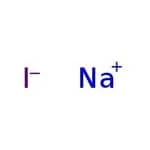Search Thermo Fisher Scientific
Natriumjodid, 99+ % (Trockengewicht, Wasser < 1.0 %), Thermo Scientific Chemicals



Natriumjodid, 99+ % (Trockengewicht, Wasser < 1.0 %), Thermo Scientific Chemicals
Chemikalien-Kennzeichnungen
Spezifikationen
Beschreibung
This Thermo Scientific Chemicals brand product was originally part of the Alfa Aesar product portfolio. Some documentation and label information may refer to the legacy brand. The original Alfa Aesar product / item code or SKU reference has not changed as a part of the brand transition to Thermo Scientific Chemicals.
Natriumjodid wird häufig für den Haloidaustausch (Finkelstein-Reaktion) verwendet, beispielsweise bei der Umwandlung von Alkylchlorid, Allylchlorid und Arylmethylchlorid in ihre jeweiligen Iodide, die wiederum Vorstufen für pharmazeutische und feinchemische Produkte sind. Sie dienen dazu, die Effizienz der Bildung von Wittig-Addukten aus weniger reaktiven Chloriden und Bromiden zu steigern. Geeignete Präparationen finden Verwendung als Nährstoffergänzung. Natriumjodid wird als Vorläufer des Kontrollmediums bei der ab-initio-Emulsionspolymerisation verwendet. Natriumjodid findet Verwendung bei der Bestimmung von gelöstem Sauerstoff in der modifizierten Winkler-Methode, Synthese des fluoreszierenden Farbstoffkupfersensor-1 (CS1) für die Bildgebung labiler Kupferpools in biologischen Proben und bei der Spaltung von Estern, Lactonen, Carbamaten und Ethern in Kombination mit Chlorotrimethylsilan.
Löslichkeit
Sehr löslich in Wasser und flüssigem Ammoniak. Frei löslich in Aceton, Ameisensäure, Formamid, Methanol und Acetonitril. Löslich in N,N-Dimethylformamid.
Hinweise
Zerschmolzen. In einem dicht verschlossenen Behälter aufbewahren. Nicht kompatibel mit starken Oxidationsmitteln und Säuren.
Abbildungen
Dokumente und Downloads
Zertifikate
Häufig gestellte Fragen (FAQ)
Zitierungen und Referenzen
Sicherheit und Handhabung
Classification of the substance or mixture
CLP classification - Regulation(EC) No 1272/2008
Label Elements
Signal Word
Danger
Hazard Statements
H315 - Causes skin irritation
H319 - Causes serious eye irritation
H372 - Causes damage to organs through prolonged or repeated exposure
H400 - Very toxic to aquatic life
Precautionary Statements
P264 - Wash face, hands and any exposed skin thoroughly after handling
P280 - Wear protective gloves/protective clothing/eye protection/face protection
P302 + P352 - IF ON SKIN: Wash with plenty of soap and water
P305 + P351 + P338 - IF IN EYES: Rinse cautiously with water for several minutes. Remove contact lenses, if present and easy to do. Continue rinsing
P314 - Get medical advice/attention if you feel unwell